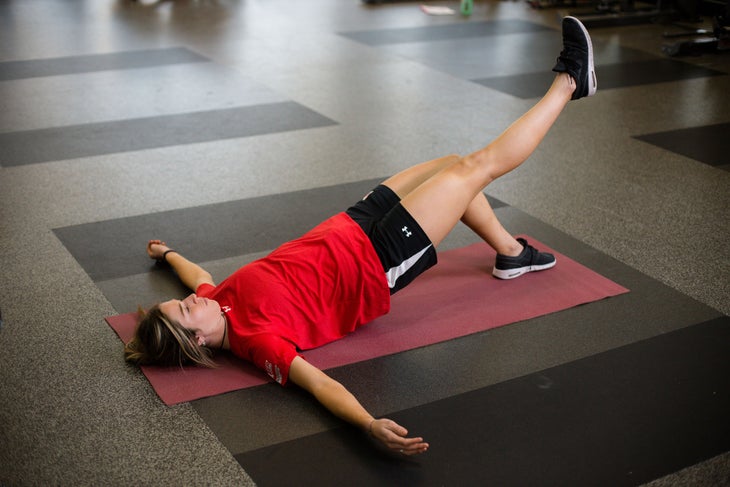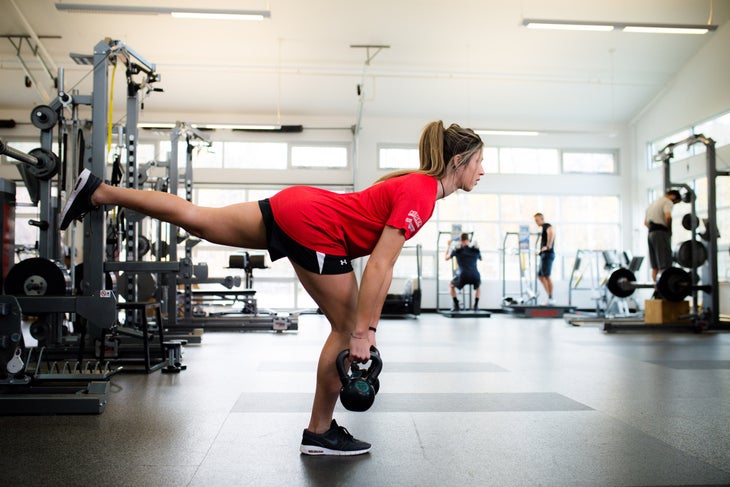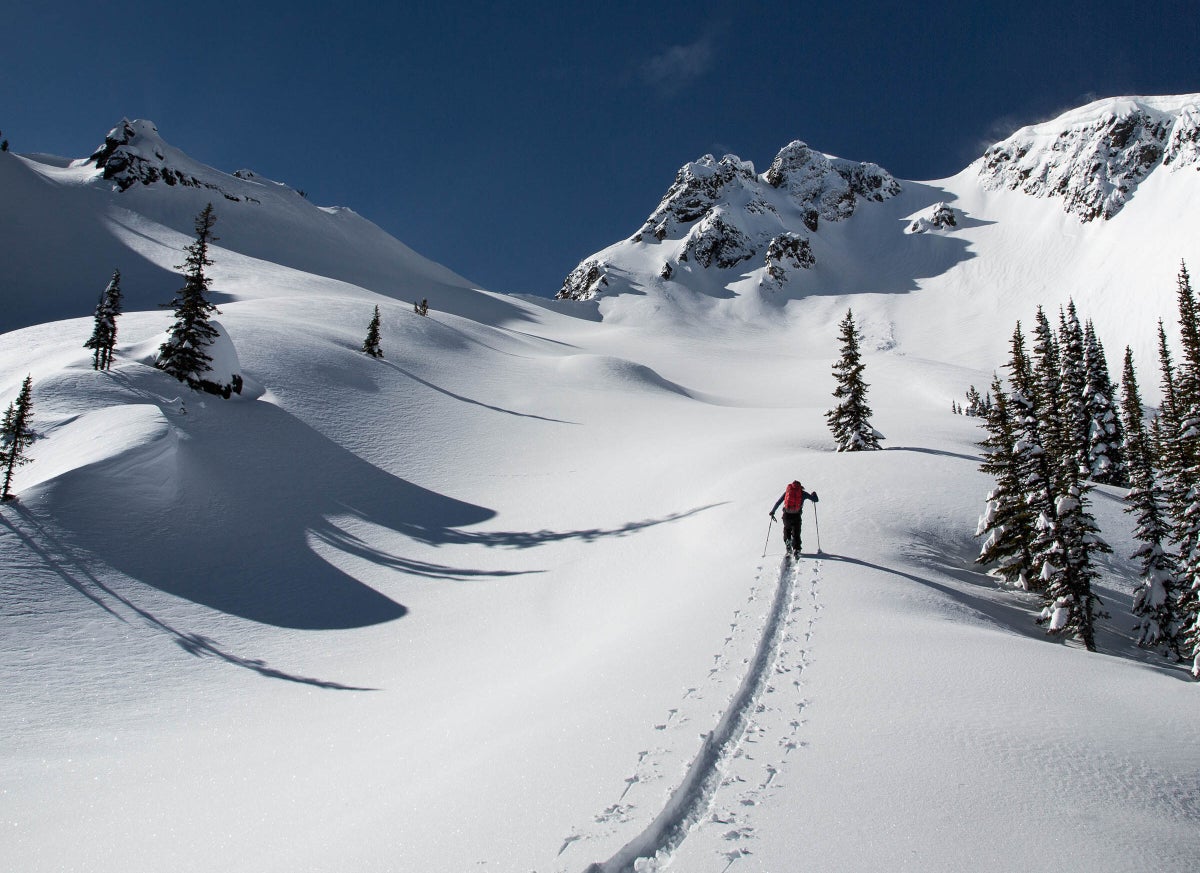Products You May Like
You’re out for a long ski tour and after lap three your hip flexors are on fire. Sound familiar? According to Esther Smith, DPT Cert. MDT, and owner of Grassroots Physical Therapy, hip flexor strains are one of the most common ailments for backcountry skiers, and most are caused by improper mechanics.
While mechanical issues might be slow to present themselves during short ski tours, once you start to get out more often, thousands and thousands of steps along the skintrack have a way of teasing out muscle imbalances and weaknesses—and most of us have a few of those.
In general, mountain athletes tend to have overdeveloped quads and hip flexors due to the type of activities they do. At the same time, they often have underdeveloped glutes and hamstrings. This kind of muscle imbalance between the anterior and posterior muscles can lead to hip flexor pain, especially during activities that require lots of muscle movement repetition, like skinning on a long ski tour.
Smith, who treats mountain athletes in Salt Lake City and Jackson Hole as well as athletes all over the world as a high performance coach for the Samsara Athlete Team, is a skier herself and has spent years treating her patients’ injuries and helping them build routines to prevent aches and pains in the first place.
The bottom line? It’s all about the booty. Keep those glutes strong and stable and you’ll be flying up the skintrack without issue. Here, Smith shares her favorite moves to prime those posterior muscles for ski touring, as well as some tips for moving more efficiently and sparing your hip flexors in the skintrack.
Glute, Hamstring, and Hip Strengthening Exercises
Three moves to fire up your posterior chain muscles and help take a load off those hip flexors.
Single-Leg Glute Bridge
Why: “This is essentially the primary action of ski touring and running mechanics,” says Smith. “It’s critical for the pillar leg to have glute action while you’re skinning or moving through a kick turn.”
 (Photo: Tory Powers)
(Photo: Tory Powers)
How: Lie with your back on the ground with legs bent to 45 degrees and feet planted on the floor. Shift weight onto one heel as you drive your hips toward the ceiling to lift into a glute bridge while raising the other leg. Hold for a beat with glutes engaged (you should feel a good burn in your glutes). Then slowly lower your hips back to the ground.
Perform 3 sets of 10 per side, 2-3 days per week
Single Leg Romanian Deadlift
Why: This single-leg exercise gets the glutes engaged while standing (a progression from lying on your back during the single-leg glute bridge), which is representative of where the power should come from in each ski touring stride. “It’s 100 percent essential in a kick turn to have glute action come from the standing leg, instead of kicking forward with your hip flexors,” says Smith.
 (Photo: Tory Powers)
(Photo: Tory Powers)
How to: Stand with feet shoulder-width apart, then shift weight onto one leg and raise the other leg behind you while you allow your upper body to hinge forward at the hips until chest is parallel to the floor. Be sure to keep hips level as you hinge forward. Hold for a beat, then lower the back leg to return to standing. Once you feel comfortable without weight, add a small weight or kettlebell, something that builds fatigue after a complete set of eight.
Perform 3 sets of 8 per side, 2-3 days per week
Starfish
Why: The starfish exercise focuses on single-leg hip stability, which is key during kick turns where one foot is stabilizing your body mid rotation.
How: Start by standing on one leg and raise the other leg out to the side until it’s parallel to the floor at about hip-height. Focus on keeping your upper body stable while lifting the leg with your lateral glutes. The standing leg works to stabilize, just like in a kick turn. Try to hold this position for 30 seconds.
Perform 3 sets of 30 seconds per side, 2-3 days per week
Tips for Proper Ski Touring Mechanics
When you’re out on the skintrack, whether or not you’re experiencing hip or lower back pain, Smith offers a few cues to keep in mind when skinning.
Glide, don’t lift
“Think about gliding your skis, not lifting or picking them up with each step, which will cause you to overuse your hip flexors,” says Smith. Dragging your toe along the skintrack is a helpful cue to keep in mind if you have the tendency to lift your feet up with each step. This not only saves your hip flexors from added strain, but also boosts efficiency and helps you save energy on a long day.
Push, don’t pull
With each stride, your power should come from the back leg, similar to the movement in the single-leg RDL exercise. Think about pushing your front leg forward, a movement that should be powered by your back glute. Smith uses the example of standing and pushing from a skateboard as an exaggerated version of where the momentum comes from.
Be conscious of your kick turns
Getting through a kick turn as quickly as possible can lead to sloppy form you might pay for later. Instead, slow down and focus on how you move your body throughout the kick turn. “Think about a big RDL to lift the leg behind, then pivot and send it forward, powered by the leg that’s planted on the ground,” says Smith. Once you feel really solid with this motion, speed it up as you get more efficient.
Read More
Improve your ski touring technique with these pro tips
Protect your ACL with these essential butt and hamstring exercises
Your low back hurts because you’re neglecting your core
